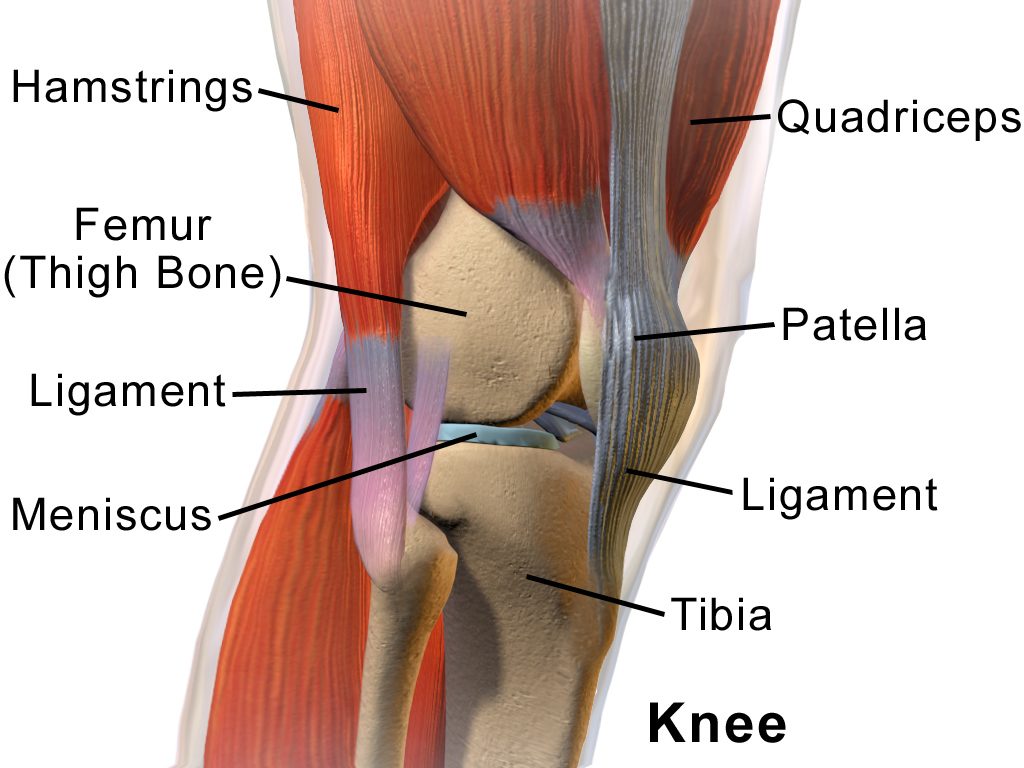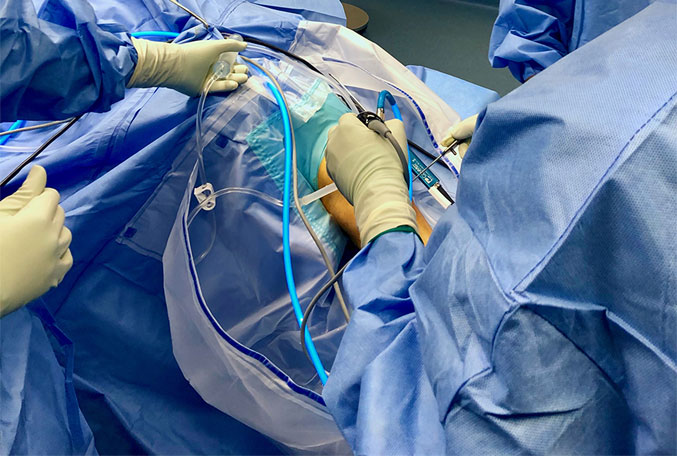Knee Arthroscopy
Knee arthroscopy is a surgical procedure that utilises small incisions to diagnose and treat a range of knee complaints including meniscal tears, cartilage damage, and ligament injuries. The knee joint, being one of the largest and most complex joints in the body, is prone to a range of injuries and conditions. Knee arthroscopy aims to treat these issues, restoring stability, relieving pain, and improving function in the knee joint with quicker recovery times compared to open surgery.
Anatomy of the Knee

Knee Anatomy (Lateral View) by Blausen.com staff (2014)/CC BY.
The knee joint consists of the femur (thigh bone), tibia (shin bone), and patella (kneecap), connected by ligaments, tendons, and cartilage. The meniscus, a C-shaped cartilage, acts as a shock absorber between the femur and tibia, while ligaments such as the anterior cruciate ligament (ACL) and medial collateral ligament (MCL) provide stability
What is Knee Arthroscopy?
Knee arthroscopy is a minimally invasive surgical procedure used to diagnose and treat various knee conditions.
It involves inserting an arthroscope, a small camera with a light source, into the knee joint through small incisions. This allows for a detailed visualisation of the knee’s internal structures, allowing necessary repairs or treatments to be performed using specialised instruments inserted through the small incisions.
During knee arthroscopy, Mr Soong Chua may perform procedures such as trimming or repairing the torn meniscus, microfracture or cartilage transplantation for cartilage damage, and reconstruction or repair of damaged ligaments for ligament injuries.
Types of Conditions Requiring a Knee Arthroscopy
Knee arthroscopy is commonly recommended for conditions such as:
- Torn Meniscus: A tear in the meniscus, the cartilage that cushions the knee joint, can cause pain, swelling, and limited mobility. Knee arthroscopy may be used to trim or repair the torn meniscus, relieving symptoms and restoring function.
- Cartilage Damage: Injuries or degenerative conditions can lead to damage or loss of cartilage, resulting in pain and stiffness. Knee arthroscopy may involve procedures such as microfracture or cartilage transplantation to stimulate the growth of new cartilage and improve joint function.
- Ligament Injuries: Tears or sprains in the knee ligaments, such as the anterior cruciate ligament (ACL) or medial collateral ligament (MCL), may require surgical intervention for stabilization and repair. Knee arthroscopy may be used to reconstruct or repair damaged ligaments, restoring stability to the knee joint.
These conditions can cause pain, swelling, and limited mobility, impacting daily activities and sports participation.

Benefits and Risks of Knee Arthroscopy
Knee arthroscopy offers several advantages over traditional open surgery, including smaller incisions, reduced pain, and faster recovery times.
However, like any surgical procedure, it carries risks such as infection, bleeding, and nerve or blood vessel damage. It’s essential for patients to discuss these risks with Mr Soong Chua and his team before undergoing the procedure.
What to Expect
Before Surgery
Prior to knee arthroscopy, patients undergo a thorough evaluation, including imaging tests and physical examination. You may need to refrain from eating or drinking for a certain period before the surgery.
During Surgery
Knee arthroscopy is typically performed as a day case or day procedure, meaning patients do not need to stay in the hospital overnight.
The surgery is performed under local anaesthesia, regional anaesthesia, or general anaesthesia, depending on your health and Mr Soong Chua’s recommendations.
During the procedure, Mr Soong Chua will make small incisions around the knee joint and insert the arthroscope and surgical instruments. The procedure may take anywhere from 30 minutes to several hours, depending on the complexity of the condition.
After Surgery
Following knee arthroscopy, patients will be monitored before being discharged home. Most patients can walk out of the hospital and return home the same day after knee arthroscopy. However, assistance such as crutches may be required, and arrangements for transportation and company at home are recommended.
Post-operative exercise and rehabilitation play a crucial role in the successful outcome of knee arthroscopy. Patients will receive exercises from a physiotherapist before leaving the hospital to ensure the knee reaches full range of movement as quickly as possible. Physical therapy sessions may continue for several weeks to months, focusing on strengthening the knee and improving flexibility to aid in the recovery process. It’s essential to follow post-operative instructions provided by the surgeon for optimal outcomes.
Pain management, elevation of the leg, ice application, and rest are also important post-operative measures. Patients may experience some pain after surgery, but medications and anti-inflammatory medications are available for short-term pain relief.
Conclusion
In summary, knee arthroscopy is vital for diagnosing and treating various knee conditions. Its minimally invasive approach and technological advancements have significantly improved patient outcomes and shortened recovery times.
With this procedure, Mr Soong Chua and his team can precisely address knee problems.
Rehabilitation, particularly physiotherapy, plays a crucial role in restoring knee strength and mobility, enabling patients to resume their daily activities.
Frequently Asked Questions
- Will I experience any pain during or after knee arthroscopy surgery?
Pain during knee arthroscopy surgery is typically minimal due to the anaesthesia used. After surgery, some discomfort or mild pain is common and can be managed with prescribed pain medications and icing of the knee. Mr Soong Chua and his team will provide guidance on pain management strategies. - Will there be any scarring after knee arthroscopy surgery?
The incisions made during knee arthroscopy surgery are small and typically result in minimal scarring. Over time, any visible scars tend to fade and become less noticeable. After surgery, Mr Soong Chua and the medical team will provide instructions on how to care for the incision sites to minimise scarring. - How soon can I resume normal activities after knee arthroscopy surgery?
Recovery time varies depending on the specific procedure performed and individual factors. Most people can gradually return to light activities within a few days to a week after surgery. However, strenuous activities and sports may need to be avoided for several weeks to allow the knee to heal properly. - Can knee arthroscopy surgery be performed on both knees simultaneously?
In some cases, bilateral knee arthroscopy (surgery on both knees at the same time) may be considered, particularly if both knees are affected by similar conditions. However, this decision is made on a case-by-case basis, taking into account factors such as overall health and surgical risk.

